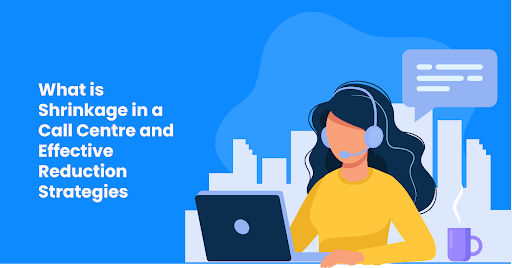In this blog, we dive deep into what shrinkage in a call centre is and how you can calculate it. We also show you how you can resolve it.
Let’s go!
Understanding what call centre shrinkage is

Consider this scenario to understand shrinkage in a call centre.
Let’s say your call centre is a restaurant that serves pizza, and your agents are the chefs. You would want them always to be busy preparing pizzas, right?
But there’s one problem.
Occasionally, your “chefs” might be in the kitchen but not cooking. We refer to that as “shrinkage”.
So here’s the definition of call centre shrinkage.
It’s the amount of time your agents are unavailable to handle customer calls despite getting paid.
Now, apply the same scenario to your call centre. Sometimes, your agents might be at the contact centre but not handling customer queries.
But what’s causing this to happen?
The answer lies in several factors.
What are the factors that cause call centre shrinkage?
From unplanned events to breaks, various factors contribute to shrinkage in your call centre.
You can categorise them into two categories – external and internal factors.
Below is a quick overview of the two categories.
| Factors of shrinkage | Examples |
| External factors | Holidays and vacations Sick days Absenteeism Punctuality (being late or leaving early) |
| Internal factors | Scheduled breaks Lunch breaks Team meetings and training sessions One-on-one meetings After-work calls |
Let’s further dissect these factors using the same scenario of the pizza shop.
We start with the external factors of shrinkage first:
- Holidays & vacations: The pizza oven remains chilly when the chefs are off. Your agents also require time off for holidays and vacations. With no agents, there’s no one to answer customer calls.
- Sick days: When chefs are ill, they cannot make pizzas. Just like that, when your agents aren’t well, they won’t be there to answer the calls.
- Absenteeism: Sometimes, your agents may skip work without giving any prior notice. This results in a staffing shortage in your contact centre.
- Being late: If your chef runs late for their shift and the customers have arrived, the pizza shop cannot serve them anything as there’s no chef to prepare food. So when your agents are late, no one can answer customer calls.
- Leaving early: If a chef leaves before the kitchen has finished closing, the kitchen gets shut down without catering to hungry customers. The same happens when your agents leave early and customers’ calls are unanswered.
Now let’s look at the internal factors of shrinkage in your call centre:
- Scheduled breaks: Everyone, even your agents, needs time to refuel. There’s nothing cooking in the kitchen when the chefs are on break. Similarly, no one’s taking customer inquiries when your agents are away.
- Lunch breaks: Your agents require the standard lunch or dinner breaks during their shifts.
- Team meetings and training: Agents must occasionally assemble for meetings or training. It’s like a chef’s workshop, except the kitchen is empty.
- One-on-one meetings: Your managers may meet with agents one-on-one. During this time, they aren’t answering calls or taking customer queries. That doesn’t imply they’re making pizzas.
- After-call work: After a chef finishes preparing a pizza, they may require a few minutes to clean up the kitchen space. Similarly, your agents must perform some added actions and steps after assisting a consumer.
In a nutshell, call centre shrinkage is analogous to the calm moments in a crowded kitchen.
But with all these factors in mind, an important question arises. How can you track and manage shrinkage in your call centre?
How do you track and manage shrinkage?
Let’s consider two examples to understand how to track and manage shrinkage in your call centre.
Consider tracking shrinkage as treasure hunting. You have both a treasure map and an accurate compass. Here’s what you do:
- Gather information: Begin by obtaining information regarding when and why shrinkage occurs. It’s like taking notes on important landmarks during your treasure hunt journey.
- Use technology: It’s like having a GPS to assist you on your treasure hunt journey. It’s faster and more accurate than figuring it out on your own. Similarly, tracking shrinkage becomes easier by using technology.
- Frequent check-ins: Just like you would check your treasure map, you should check your shrinkage data regularly. This guarantees that you remain on the proper track.
Tracking and managing shrinkage in your call centre goes side by side.
Managing shrinkage is like being the ship’s captain- ensuring you get the wind for your journey.
Here’s how you can better manage shrinkage in a call centre:
- Smart scheduling: Create schedules for each shift using call centre software like TelebuHub to reduce shrinkage. TelebuHub’s scheduling feature helps you create shifts that align with peak call times to ensure the availability of agents.
- Improve team skills: Give your team the necessary skills and training to manage a variety of duties. It’s similar to having a versatile crew that can deal with various situations at sea.
- Automate work: Automate repetitive operations to free up your agents’ time. Check out the automation you’d need in your call centres.
- Ensure flexibility: Provide your team with flexible schedules. It’s like letting your workers pick the greatest shifts.
Remember that you cannot manage or track shrinkage in your call centre if you don’t know how to calculate it.
What is the importance of shrinkage calculation?

There are four major reasons why it’s important to calculate your call centre’s shrinkage:
- Sailing with ease: You check the weather forecast while planning a road trip. Calculating shrinkage is similar. It helps you prepare for hurdles so your call centre journey runs smoothly.
- Managing resources: Just like you get adequate snacks and gas for your road trip, assessing shrinkage helps you manage your call centre’s resources efficiently. You want to ensure you have everything you need for the entire journey.
- Staying on course: Calculating shrinkage helps you meet your goals, like providing excellent customer service, without wandering off the track.
- Sticking to budget: By calculating shrinkage, you keep track of your budget and expenses.
Calculating shrinkage assists you in planning, allocating resources wisely, and staying within your budget.
How do you calculate shrinkage?
All you need is a simple formula.
The shrinkage formula. Don’t worry; this is no mathematical maze.
Here’s the formula:

Shrinkage (%) = (Total Time Doing Other Stuff / Total Available Time) * 100%
Let’s simplify it for easier understanding:
- Total time doing other stuff: This is the time your team spends on things other than talking to customers.
- Total available time: This is the total time duration your call centre is operational to serve the customers. It’s like the entire duration of your road trip.
- Multiply by 100%: You multiply to change the result into a percentage to make it easier to understand.
Here’s an example.
Let’s say your call centre operates 24 hours a day.
Your agents spend 5 hours on breaks, meetings, and other non-customer activities.
Using the shrinkage formula:
Shrinkage (%) = (5 hours / 24 hours) * 100% = 20.83%
How can you reduce shrinkage in your call centre?
Here are some tips to help you tackle shrinkage:
- Transparent communication: Start by openly discussing the importance of minimising shrinkage with your team. Explain how it impacts overall performance and customer satisfaction. When everyone understands the goal, they’re more likely to be on board with efforts to reduce it.
- Effective scheduling: Work with your workforce management team to create schedules that align with call volume patterns. By accurately forecasting demand and scheduling breaks and meetings accordingly, you can minimise idle time and maximise productivity during peak hours.
- Flexible break management: Offer flexibility in break scheduling whenever possible. Allowing agents to choose their break times within certain guidelines can help ensure breaks are staggered, reducing the likelihood of a large portion of the team being idle simultaneously.
- Encourage time management: Provide training and resources to help agents manage their time effectively. This includes techniques for quickly transitioning between calls, handling administrative tasks efficiently, and prioritising workload.
- Utilise technology: Invest in workforce management software that can help you track shrinkage in real time and identify trends or areas for improvement. These tools can also automate scheduling processes and optimise staffing levels based on historical data.
- Incentivise performance: Implement incentives or rewards for agents who consistently meet or exceed productivity targets while minimising shrinkage. Positive reinforcement can motivate employees to stay focused and engaged during their shifts.
- Continuous monitoring and feedback: Regularly monitor shrinkage metrics and provide constructive feedback to agents and supervisors. Use performance reviews as an opportunity to discuss areas of improvement and brainstorm strategies together.
What is the difference between shrinkage and utilisation?

Shrinkage is the time your agents spend on things other than helping customers.
This can include attending meetings or a training session.
Utilisation is the time they spend serving your customers.
This includes answering and resolving their queries.
Shrinkage is like one side of a seesaw, and utilisation is the other. It’s all about keeping the perfect balance.
You want to ensure the seesaw stays level so your customers get the best service.
How does shrinkage affect customer experience?
It’s simple.
The greater the shrinkage in your call centre, the more it will have a negative impact on customer experience.
It’s all about ensuring that the customers ringing your call centre hang up with a smile and satisfaction.
You want your agents to spend maximum time answering calls to ensure a low level of shrinkage.
Ready to reduce shrinkage in your call centre?
Make the best use of your agents’ time
While your agents are at work serving customers, the best call centre solution will enable them to make the best use of their working time. That is where you need TelebuHub.
With TelebuHub’s wide-range features, you can:
- Manage tasks to ensure your team spends less time on other activities and more time serving customers.
- Automate routine tasks to free up your team to focus on providing top-notch customer service.
- Offer flexible scheduling options to make your team more productive.
- Enhance the overall experience to ensure your customers get a seamless experience.
Schedule a demo to see how TelebuHub can help you delight your agents and customers.






0 Comments